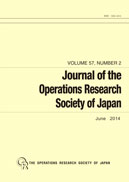Volume 44, Issue 4
Displaying 1-15 of 15 articles from this issue
- |<
- <
- 1
- >
- >|
-
Article type: Cover
2001Volume 44Issue 4 Pages Cover9-
Published: 2001
Released on J-STAGE: June 27, 2017
Download PDF (19K) -
Article type: Appendix
2001Volume 44Issue 4 Pages App7-
Published: 2001
Released on J-STAGE: June 27, 2017
Download PDF (64K) -
Article type: Article
2001Volume 44Issue 4 Pages 301-312
Published: 2001
Released on J-STAGE: June 27, 2017
Download PDF (766K) -
Article type: Article
2001Volume 44Issue 4 Pages 313-325
Published: 2001
Released on J-STAGE: June 27, 2017
Download PDF (917K) -
Article type: Article
2001Volume 44Issue 4 Pages 326-343
Published: 2001
Released on J-STAGE: June 27, 2017
Download PDF (1812K) -
Article type: Article
2001Volume 44Issue 4 Pages 344-365
Published: 2001
Released on J-STAGE: June 27, 2017
Download PDF (1135K) -
Article type: Article
2001Volume 44Issue 4 Pages 366-377
Published: 2001
Released on J-STAGE: June 27, 2017
Download PDF (762K) -
Article type: Article
2001Volume 44Issue 4 Pages 378-389
Published: 2001
Released on J-STAGE: June 27, 2017
Download PDF (1180K) -
Article type: Article
2001Volume 44Issue 4 Pages 390-402
Published: 2001
Released on J-STAGE: June 27, 2017
Download PDF (1021K) -
Article type: Appendix
2001Volume 44Issue 4 Pages 403-404
Published: 2001
Released on J-STAGE: June 27, 2017
Download PDF (118K) -
Article type: Appendix
2001Volume 44Issue 4 Pages 405-
Published: 2001
Released on J-STAGE: June 27, 2017
Download PDF (60K) -
Article type: Index
2001Volume 44Issue 4 Pages 406-407
Published: 2001
Released on J-STAGE: June 27, 2017
Download PDF (96K) -
Article type: Appendix
2001Volume 44Issue 4 Pages App8-
Published: 2001
Released on J-STAGE: June 27, 2017
Download PDF (218K) -
Article type: Cover
2001Volume 44Issue 4 Pages Cover10-
Published: 2001
Released on J-STAGE: June 27, 2017
Download PDF (38K) -
Article type: Cover
2001Volume 44Issue 4 Pages Cover11-
Published: 2001
Released on J-STAGE: June 27, 2017
Download PDF (38K)
- |<
- <
- 1
- >
- >|
